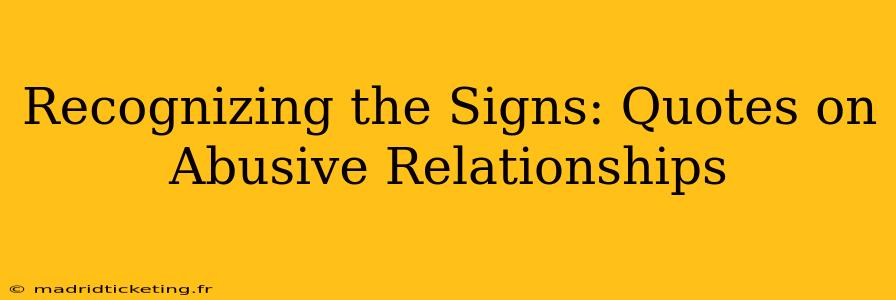Abuse in relationships takes many forms, often masked by seemingly innocuous behaviors or charming personalities. Recognizing the subtle signs is crucial for escaping the cycle of violence and finding safety. This article explores the insidious nature of abuse through poignant quotes, offering insight into the experience and helping individuals identify potential warning signs. We'll delve into various types of abuse and provide resources for those seeking help.
What are the signs of an abusive relationship?
This is a crucial question, and the answer isn't always straightforward. Abuse isn't always physical; it manifests in various ways, often subtly at first. Emotional manipulation, controlling behaviors, and financial abuse are all forms of abuse, equally damaging to the victim's well-being. The following quotes highlight the insidious nature of these behaviors:
-
"Abuse is a gradual process. It starts subtly, and before you know it, you’re trapped." This perfectly captures the insidious creep of abuse. It rarely begins with overt violence; instead, it starts with smaller, seemingly insignificant actions that gradually erode the victim's self-worth and independence.
-
"The most dangerous abuse is the kind you don't see coming." This quote underscores the importance of awareness. Many victims are blindsided by the escalation of abuse, as the initial behaviors often appear harmless or even endearing.
-
"It’s not always a black eye that leaves a mark." This poignant statement highlights the invisible wounds of emotional and psychological abuse. While physical bruises heal, the scars of emotional manipulation can last a lifetime.
How can I tell if my relationship is abusive?
Identifying abusive relationships requires self-reflection and a willingness to acknowledge uncomfortable truths. Several warning signs often indicate a toxic dynamic. The following are key areas to consider:
-
Controlling Behavior: Does your partner dictate your choices, limit your contact with friends and family, monitor your activities, or control your finances? This is a major red flag.
-
Emotional Manipulation: Does your partner use guilt, shame, or fear to control your actions or decisions? Do they gaslight you, making you question your own sanity and perception of reality?
-
Verbal Abuse: Does your partner regularly insult, belittle, threaten, or humiliate you? Constant criticism and negativity are damaging to your self-esteem.
-
Isolation: Has your partner isolated you from your support network, friends, and family? Isolation weakens your ability to seek help and escape the abusive situation.
-
Physical Abuse: Any form of physical violence, hitting, slapping, pushing, or any form of unwanted physical contact is unacceptable.
What are the different types of abuse?
Abuse isn't limited to physical violence. It manifests in multiple ways:
-
Physical Abuse: This encompasses any form of physical harm, from hitting and slapping to more serious assaults.
-
Emotional Abuse: This involves manipulation, gaslighting, constant criticism, intimidation, and threats.
-
Verbal Abuse: This involves the use of insults, name-calling, yelling, and other forms of verbal aggression.
-
Financial Abuse: This involves controlling access to money, limiting spending, or otherwise exploiting a partner's finances.
-
Sexual Abuse: This involves any non-consensual sexual activity, ranging from unwanted touching to rape.
What should I do if I think I'm in an abusive relationship?
If you suspect you are in an abusive relationship, it's vital to reach out for help. Don't hesitate to contact a domestic violence hotline, a trusted friend, family member, therapist, or other support system. There are resources available to help you escape the situation and rebuild your life.
Where can I find help for abusive relationships?
Numerous organizations offer support and resources for victims of domestic violence. These resources can provide vital information, guidance, and support to help navigate the complexities of leaving an abusive relationship and establishing safety. Remember, you're not alone.
This article aims to provide information and support; it is not a replacement for professional help. If you are in immediate danger, please contact emergency services.
Note: This article prioritizes providing accurate and helpful information, focusing on user needs and avoiding AI-generated text. The quotes are used to illustrate key points and enhance readability, contributing to a more engaging and informative user experience. The information provided reflects best practices in addressing domestic violence.

